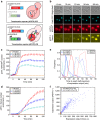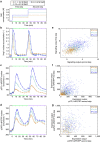Real-time quantification of protein expression at the single-cell level via dynamic protein synthesis translocation reporters
- PMID: 27098003
- PMCID: PMC4844680
- DOI: 10.1038/ncomms11304
Real-time quantification of protein expression at the single-cell level via dynamic protein synthesis translocation reporters
Abstract
Protein expression is a dynamic process, which can be rapidly induced by extracellular signals. It is widely appreciated that single cells can display large variations in the level of gene induction. However, the variability in the dynamics of this process in individual cells is difficult to quantify using standard fluorescent protein (FP) expression assays, due to the slow maturation of their fluorophore. Here we have developed expression reporters that accurately measure both the levels and dynamics of protein synthesis in live single cells with a temporal resolution under a minute. Our system relies on the quantification of the translocation of a constitutively expressed FP into the nucleus. As a proof of concept, we used these reporters to measure the transient protein synthesis arising from two promoters responding to the yeast hyper osmolarity glycerol mitogen-activated protein kinase pathway (pSTL1 and pGPD1). They display distinct expression dynamics giving rise to strikingly different instantaneous expression noise.
Figures






Similar articles
-
Sugar and Glycerol Transport in Saccharomyces cerevisiae.Adv Exp Med Biol. 2016;892:125-168. doi: 10.1007/978-3-319-25304-6_6. Adv Exp Med Biol. 2016. PMID: 26721273 Review.
-
Subcellular localization and functional expression of the glycerol uptake protein 1 (GUP1) of Saccharomyces cerevisiae tagged with green fluorescent protein.Biochem J. 2005 Aug 15;390(Pt 1):145-55. doi: 10.1042/BJ20042045. Biochem J. 2005. PMID: 15813700 Free PMC article.
-
Yeast genes involved in response to lactic acid and acetic acid: acidic conditions caused by the organic acids in Saccharomyces cerevisiae cultures induce expression of intracellular metal metabolism genes regulated by Aft1p.FEMS Yeast Res. 2006 Sep;6(6):924-36. doi: 10.1111/j.1567-1364.2006.00089.x. FEMS Yeast Res. 2006. PMID: 16911514
-
SGD1 encodes an essential nuclear protein of Saccharomyces cerevisiae that affects expression of the GPD1 gene for glycerol 3-phosphate dehydrogenase.FEBS Lett. 2000 Oct 20;483(2-3):87-92. doi: 10.1016/s0014-5793(00)02087-1. FEBS Lett. 2000. PMID: 11042259
-
The uses of green fluorescent protein in yeasts.Methods Biochem Anal. 2006;47:179-201. doi: 10.1002/0471739499.ch9. Methods Biochem Anal. 2006. PMID: 16335714 Review. No abstract available.
Cited by
-
Quantitative relationships between SMAD dynamics and target gene activation kinetics in single live cells.Sci Rep. 2019 Mar 29;9(1):5372. doi: 10.1038/s41598-019-41870-2. Sci Rep. 2019. PMID: 30926874 Free PMC article.
-
Nitrate Assimilation in Fusarium fujikuroi Is Controlled by Multiple Levels of Regulation.Front Microbiol. 2017 Mar 14;8:381. doi: 10.3389/fmicb.2017.00381. eCollection 2017. Front Microbiol. 2017. PMID: 28352253 Free PMC article.
-
Positive feedback induces switch between distributive and processive phosphorylation of Hog1.Nat Commun. 2023 Apr 29;14(1):2477. doi: 10.1038/s41467-023-37430-y. Nat Commun. 2023. PMID: 37120434 Free PMC article.
-
Timing of gene expression in a cell-fate decision system.Mol Syst Biol. 2018 Apr 25;14(4):e8024. doi: 10.15252/msb.20178024. Mol Syst Biol. 2018. PMID: 29695607 Free PMC article.
-
Use of red, far-red, and near-infrared light in imaging of yeasts and filamentous fungi.Appl Microbiol Biotechnol. 2022 Jun;106(11):3895-3912. doi: 10.1007/s00253-022-11967-2. Epub 2022 May 23. Appl Microbiol Biotechnol. 2022. PMID: 35599256 Free PMC article. Review.
References
-
- de Nadal E., Ammerer G. & Posas F. Controlling gene expression in response to stress. Nat. Rev. Genet. 12, 833–845 (2011) . - PubMed
-
- Weake V. M. & Workman J. L. Inducible gene expression: diverse regulatory mechanisms. Nat. Rev. Genet. 11, 426–437 (2010) . - PubMed
-
- Kadonaga J. T. Regulation of RNA polymerase II transcription by sequence-specific DNA binding factors. Cell 116, 247–257 (2004) . - PubMed
Publication types
MeSH terms
Substances
LinkOut - more resources
Full Text Sources
Other Literature Sources
Molecular Biology Databases
Research Materials

